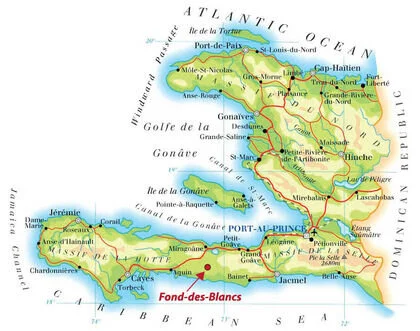History
A Brief History of Fond-des-Blancs
The 40-village commune of Fond-des-Blancs is located in an isolated mountainous region of the southern peninsula of Haiti. There has been little investment in infrastructure and transportation is difficult.
The inhabitants had been farmers for generations, but due to a variety of factors including environmental hardships, soil depletion and erosion, and the call away from their rural area to large cities, many have increasingly been abandoning farming and turning to other means of income.
Turning away from agriculture has led to a reliance on a predominantly starch-based diet of rice, corn, beans, and yams, although heavily influenced by French cuisine from the days of when France ruled. Meat is a delicacy in this area and is consumed mostly by wealthy residents elsewhere. Poverty was a driver in much of the actions of the villagers of the 20th century in Fond-des-Blancs, such as charcoal and lumber production and urban migration.
There were three periods of big "urban migration":
1960s: creation of the Airport Industrial Park, and around it Cité Soleil
1981: active recruitment of Haitian workers for sugar cane plantations in the Dominican Republic
1987: consequences of policies adopted by the Haitian Government, under the International Monetary Fund pressure that plummeted native crop prices in Haiti.
Deforestation resulted from the desire to generate life-sustaining income combined with natural disasters leaving the region challenged to self-correct to a more sustainable lifestyle. Today, Haiti is the poorest country in the western hemisphere and the people in its most vulnerable rural areas are in a desperate struggle for survival.
Origins of Greening Haiti Fund
After almost 25 years’ involvement with the community of Fond-des-Blancs, Sarah Hackett was about to retire as president of Haiti Projects when she discovered none of the produce for sale in the local farmers’ market had been produced locally. Farming was no longer providing sufficient income.
The forest cover that had once been a key to Haiti’s fertility was being rapidly destroyed. Trees were cut for charcoal not only for cooking but increasingly for charcoal and lumber production to gain income, exacerbating the problem. The practice of clearing land by cutting trees and burning the remaining vegetation instead of composting it to return nutrients to the soil was further depleting the soil.
2017
Greening Haiti Fund, Inc., (GHF) was launched with the goal of reestablishing local food production. From the outset, the involvement of the local community was a vital part of this initiative. An environmental education program was developed for adults and children to encourage sustainable agricultural practices which will revitalize soil. A nursery was envisioned to provide tree seedlings of various types to the community for shade, food and income.
See Mission & Approach for more details.
2018
Community Collaboration
CEO Emerson’n Vibert and Director of Education Jacques Poulard, both trained agronomists, regularly speak with community members about GHF programming and development opportunities.
Sustainable Solutions
In addition to introducing composting techniques to the community, GHF built a small-scale rabbit farm to collect rabbit manure - a “cold” manure that can be used immediately as a soil amendment.
Intentional Implementation
To address shade, cooking fuel, and nutritional concerns, our certified agrotechnicians grow and care for over 30 varieties of tree seedlings including avocado, cashew, cedar, coffee, grapefruit, moringa, orange, Spanish oak, tamarind, and more.
2019
Consistent Engagement
The May Day 2019 planting event, one of the community’s largest events.
By the end of 2019, GHF had grown, distributed, and successfully planted over 26,000 tree seedlings throughout Fond-des-Blancs.
2020
Increasing Production
Our new water truck, purchased in Florida and shipped to Haiti, helps tremendously to increase the viability of tens of thousands of seedlings.






